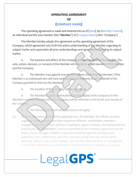How to Raise Startup Capital Without Giving Away Your Company
Raising startup capital often feels like choosing between growth and control. Many entrepreneurs believe they must sacrifice significant equity to...
9 min read
LegalGPS : Nov. 21, 2025
Choosing between a SAFE (Simple Agreement for Future Equity) and convertible notes for your startup funding can determine whether you maintain control of your company or accidentally give away more equity than intended. This decision affects everything from your tax obligations to your ability to raise future rounds, yet many entrepreneurs rush into agreements without understanding the long-term consequences.


Legal GPS Pro
Protect your business with our complete legal subscription service, designed by top startup attorneys.
The wrong choice can cost you hundreds of thousands in unnecessary dilution or trap you in unfavorable terms that make future funding nearly impossible. Smart founders understand these instruments before they need them, not when investors are pressuring them to sign.
Before diving into which option protects you better, you need to understand what you're actually signing. Both SAFEs and convertible notes serve as bridge financing that converts to equity later, but they operate under fundamentally different legal frameworks.
A SAFE is a relatively new funding instrument created by Y Combinator in 2013. It's designed to be simpler than convertible notes while providing early-stage funding without immediately determining your company's valuation. When you sign a SAFE, you're promising investors equity in a future priced round, typically your Series A.
The beauty of SAFEs lies in their simplicity. There's no interest rate, no maturity date, and no debt on your balance sheet. Investors give you money today in exchange for the right to convert their investment into equity when you raise your next qualifying round.

SAFE Agreement (Simple Agreement for Future Equity)
Use our SAFE Agreement Template to enable startups and investors to formalize funding terms where investment converts into future equity upon triggering events, simplifying early-stage capital raising.
Trusted by 1,000+ businesses to safeguard their LLCs.
Convertible notes are technically debt instruments that convert to equity under specific conditions. Unlike SAFEs, they include interest rates (typically 2-8% annually) and maturity dates (usually 18-24 months). If your startup doesn't raise a qualifying round before the maturity date, investors can demand repayment of the principal plus accrued interest.
This debt structure provides investors with additional protection. If your company fails to raise subsequent funding, they have legal recourse as creditors rather than just disappointed equity holders.
Both SAFEs and convertible notes typically include valuation caps and discount rates. A valuation cap sets the maximum company value at which the investment converts to equity, protecting early investors from excessive dilution if your company's value skyrockets. Discount rates (usually 10-30%) give investors a price break compared to future round participants.
Understanding the subtle but crucial differences between these instruments can save you from costly mistakes that plague many first-time founders.
The most significant difference lies in how each instrument appears on your financial statements. Convertible notes create actual debt that must be reported on your balance sheet, while SAFEs are considered equity instruments that don't create debt obligations.
This distinction matters when you're applying for loans, lines of credit, or grants that have debt-to-equity requirements. Many government programs and traditional lenders view high debt levels unfavorably, potentially limiting your access to additional capital sources.
Convertible notes accrue interest over time, increasing the amount that eventually converts to equity. This means you're giving away more of your company the longer it takes to raise your next round. SAFEs don't have this compounding effect, making them more predictable for dilution planning.
Maturity dates create additional pressure. If you can't raise a qualifying round before your convertible notes mature, you may face demands for cash repayment that most early-stage startups can't meet. This scenario often forces unfavorable renegotiations or emergency funding rounds.
Convertible note holders typically have more rights as creditors, including potential board seats or veto powers over major decisions if the notes go into default. SAFE holders generally have fewer interim rights, waiting until conversion to gain standard equity protections.
Sarah Martinez founded TechStart, a B2B software company, and needed $500K for product development. She chose a SAFE with a $4M valuation cap and 20% discount rate. Six months later, when she raised a $2M Series A at a $10M pre-money valuation, her SAFE investors converted at the $4M cap.
This decision saved Sarah significant dilution. If she had used convertible notes at 6% annual interest, the extra $15K in accrued interest would have meant giving away additional equity. More importantly, the lack of a maturity date removed pressure to rush her Series A, allowing her to negotiate better terms with multiple interested VCs.
The SAFE structure also kept her balance sheet clean, which proved crucial when applying for a $100K government innovation grant that had strict debt-to-equity requirements.
Choose SAFEs when you're confident about raising a Series A within 12-18 months and want maximum flexibility. Opt for convertible notes when investors demand more protection or you're uncertain about your funding timeline.
The financial impact of your choice extends far beyond the initial investment amount, affecting everything from your tax obligations to your company's attractiveness to future investors.
With SAFEs, your dilution is straightforward to calculate since there's no interest component. Take your investment amount, divide by the lower of your valuation cap or the discounted Series A price, and you know exactly how much equity you're giving up.
Convertible notes add complexity through accrued interest. A $100K note with 6% annual interest becomes $106K after one year, $112.36 after two years. This growing number means you're giving away more equity the longer you wait to convert.
SAFEs generally don't create immediate tax obligations for either party. The investment isn't income for your company, and conversion is typically a non-taxable exchange. Convertible notes can create more complex tax situations, particularly if the notes include features like participation rights or PIK (payment-in-kind) interest.
Interest payments on convertible notes may be deductible as business expenses, but the timing and method of deduction can vary based on your accounting method and specific note terms.
Investors in later rounds often view SAFEs more favorably because they don't create debt overhang that could complicate the investment. Convertible notes approaching maturity can be red flags for Series A investors, who may worry about forced conversions or repayment obligations affecting the deal structure.
David Kim's mobile gaming startup, MobileApp, raised $750K through convertible notes with 18-month maturity dates. When their Series A took longer than expected due to market conditions, three of their five investors demanded maturity extensions with increased interest rates.
The negotiation process consumed two months and significant legal fees, ultimately resulting in higher interest rates that increased their total conversion amount by $45K. Meanwhile, potential Series A investors viewed the extended notes as a sign of trouble, making fundraising even more challenging.
If David had used SAFEs instead, he would have avoided the maturity pressure entirely, allowing him to focus on growing the business rather than managing investor relations during a critical period.
Always model your cap table through multiple scenarios before choosing your funding instrument. Factor in potential interest accrual, different conversion timing, and various Series A valuations to understand the true cost of each option.
Understanding what motivates investors can help you choose the right instrument and negotiate better terms for both parties.
Conservative investors often prefer convertible notes because of the debt protection they provide. If your startup fails, note holders have priority over equity holders in liquidation proceedings. This downside protection can be crucial for investors with fiduciary responsibilities or limited risk tolerance.
Growth-focused investors may prefer SAFEs because they align incentives purely around equity upside. Without debt obligations or maturity pressures, both founders and investors can focus on building long-term value rather than managing short-term conversion triggers.
Sophisticated investors understand that convertible notes provide more legal remedies if things go wrong. Default provisions can trigger acceleration clauses, board representation rights, or even control provisions that don't exist with SAFEs.
SAFE investors rely primarily on their conversion rights and standard minority protection provisions that kick in only after conversion. This means they have fewer tools to influence company direction during the bridge period.
In acquisition scenarios, convertible notes often convert automatically, while SAFE conversion may depend on the specific deal structure. Some acquirers prefer to assume debt obligations rather than deal with complex equity calculations, making convertible notes more attractive in certain exit situations.
Jennifer Walsh's data analytics startup, DataCorp, successfully used both instruments strategically. She raised $300K through SAFEs from angel investors who wanted simple terms and aligned incentives. Six months later, she raised an additional $400K through convertible notes from a corporate strategic investor who required the additional protections.
This hybrid approach gave her flexibility with the angels while satisfying the corporate investor's risk management requirements. When DataCorp raised their Series A eighteen months later, both instruments converted smoothly without conflicts or complications.
The key was clear communication with all parties about the different terms and ensuring the convertible notes had appropriate subordination provisions to avoid conflicts between investor classes.
Even experienced entrepreneurs make costly errors when structuring these agreements, often because they focus on getting money quickly rather than understanding long-term implications.
Setting your valuation cap too low is one of the most expensive mistakes founders make. Some entrepreneurs, desperate for funding, agree to caps that give away massive equity if their company succeeds. A $2M cap might seem reasonable when you're pre-revenue, but it becomes devastating if you raise your Series A at a $20M valuation.
Conversely, setting caps too high can make your investment unattractive to early investors who want meaningful upside for their risk. The key is finding a cap that rewards early believers while preserving reasonable equity for future rounds.
Many founders treat discount rates as negotiable sweeteners without understanding their mathematical impact. A 25% discount on a $10M Series A valuation means early investors effectively paid $7.5M valuation rates. Combined with a low valuation cap, this can create double-digit dilution from relatively small investments.
Using online templates or lawyer-drafted agreements without proper review creates hidden landmines. Standard SAFE agreements have evolved through multiple versions, each addressing problems discovered in earlier iterations. Using outdated templates can create conversion ambiguities that cost you dearly during your Series A.
Michael Chen's cloud software startup, CloudSoft, used an early version SAFE template for their $500K round. The agreement lacked provisions for handling a down round scenario, where the Series A price would be lower than the SAFE's conversion terms.
When CloudSoft eventually raised their Series A at a lower valuation due to market conditions, the ambiguous conversion language triggered a six-month legal dispute. The resolution required expensive attorney involvement and ultimately cost the company an additional $75K in legal fees and delayed funding.
Proper legal review would have identified this issue early and included appropriate provisions for various conversion scenarios.
Always have both instruments reviewed by an experienced startup attorney, even if you're using standard templates. The cost of proper legal review ($2K-5K) is minimal compared to the potential downside of problematic terms.
The decision between SAFEs and convertible notes should align with your specific situation, timeline, and investor requirements rather than following generic advice.
Choose SAFEs when you have a clear path to Series A funding within 12-18 months and want to maintain maximum flexibility. They work particularly well for software companies with predictable development timelines and angel investors who understand equity investments.
SAFEs are also ideal when you're raising smaller amounts ($25K-500K) where the administrative overhead of convertible notes isn't justified. The simplified terms reduce legal costs and negotiation time, allowing you to focus on building your business.
Convertible notes make sense when investors require additional protection or when your funding timeline is uncertain. They're often necessary for larger bridge rounds ($500K+) or when raising from institutional investors with specific fiduciary requirements.
Notes also work better when you need to coordinate multiple investors with different risk profiles. The debt structure provides a common framework that conservative investors understand, even if some terms need customization.
Some startups successfully use both instruments simultaneously, typically offering SAFEs to angel investors and convertible notes to institutional or strategic investors. This approach requires careful coordination to avoid conflicts during conversion, but it can satisfy different investor requirements while maintaining founder flexibility.
Lisa Rodriguez's financial technology startup, FinTech, developed a systematic approach to choosing funding instruments based on investor type and check size. Angels investing under $50K received SAFE agreements with standard terms. Investors writing $100K+ checks could choose between SAFEs and convertible notes based on their preferences.
This flexible approach allowed FinTech to close their $1.2M bridge round in just six weeks, with 70% choosing SAFEs and 30% opting for convertible notes. The clear framework eliminated confusion and negotiation delays while accommodating different investor needs.
When they raised their Series A eight months later, both instrument types converted smoothly according to their predetermined terms.
Regardless of which instrument you choose, certain protective measures can prevent common problems that arise during conversion or future funding rounds.
Most favored nation (MFN) clauses ensure that if you offer better terms to future SAFE or note investors, existing investors receive the same benefits. This protection works both ways, preventing you from accidentally disadvantaging early supporters while ensuring you don't get locked into inferior terms.
Pro rata rights allow investors to maintain their ownership percentage in future rounds. While not always necessary for small investments, these rights can be valuable for maintaining relationships with strategic investors who provide ongoing value beyond capital.
Automatic conversion triggers that activate based on company actions rather than funding events can create unwanted dilution at inappropriate times. Some agreements convert upon reaching certain revenue milestones or time periods, potentially forcing equity distribution when you least want it.
Broad participation rights that allow investors to receive both their preferred return and common stock upside can create excessive dilution in successful scenarios. These terms are more common in convertible notes but can occasionally appear in customized SAFE agreements.
Maintain detailed cap table models that track all potential conversion scenarios throughout your fundraising process. Update these models whenever you modify terms or add investors to ensure you understand the cumulative dilution impact.
Create standardized term sheets for each instrument type to speed negotiations and reduce legal costs. Having pre-approved terms for different investment sizes and investor types eliminates repeated negotiations over standard provisions.
Armed with this knowledge, you can make an informed decision about which funding instrument best serves your startup's needs. Start by modeling both scenarios using your specific terms and conversion assumptions.
Consider your investor base, funding timeline, and risk tolerance when making your choice. Remember that you can always use different instruments for different rounds as your company evolves and your needs change.
Most importantly, don't let funding urgency force you into unfavorable terms. The extra time spent understanding these instruments and negotiating appropriate terms will save you significant money and complications as your company grows.
Legal GPS offers professionally drafted SAFE and convertible note templates that include the protective provisions discussed in this article. Our Pro subscription provides access to attorney consultations that can help you customize these agreements for your specific situation, ensuring you get the protection you need without overpaying for unnecessary complexity.

Legal GPS Pro
Protect your business with our complete legal subscription service, designed by top startup attorneys.
|
Premium Template
Single-use Template |
Legal GPS Pro
Unlimited Access, Best Value |
|
|
| Choose Template | Learn More |
| Trusted by 1000+ businesses | |
Table of Contents

Raising startup capital often feels like choosing between growth and control. Many entrepreneurs believe they must sacrifice significant equity to...

Today is an exciting time to start your own business. The capital available to startups has tripled in recent years, and there are many investors...

Securing funding is one of the most important—and challenging—tasks for early-stage startups. The type of funding you pursue and when you pursue it...